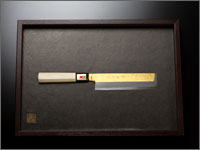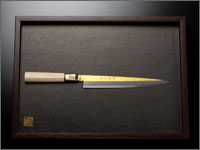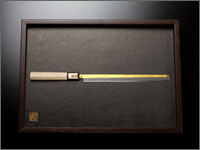The Knife Gilded with Gold

"New Japanese traditional crafts gilded shining in gold" Through the fusion between the Sakai Hocho or Japanese blades produced in Sakai gaining worldwide recognition and eternally-shining gold, the status of this knife that used to be the mere cooking tools in the past has been now upgraded to be incorporated into the realm of the work of art. And the knives are the crafted products with which you can enhance the excitement of your customers, while you are showing them the scene of your cooking.
The gold with eternal shine, Echizen washi (handmade Japanese papers manufactured in the former Echizen province) and sumi (black ink) produced in the Nara region of Japan that will remain even after more than 1000 years pass, as well as the Sakai Hocho or Japanese blades produced in Sakai which can cut up all the evils.
This is ideal for your gift to your precious ones as well as for your collection, or you can actually use these as cooking tools as well.










